|
Introduction
Art and culture
have great significance in the
creation of nations and national
identities. Art was understood as
the embodiment of the national
spirit and testimony to its
existence, as well as a means for
creating a nation. The historical
processes of creating Yugoslav art
and culture, as well as their fates
show just that. The rise and fall of
the idea of Yugoslav art occurred
during three different historical
periods – the period until the
unification in 1918, in the Kingdom
of Serbs, Croats and
Slovenes/Yugoslavia and in the
socialist Yugoslav state. The
dynamics of the emergence and
duration of the idea of Yugoslav art
was determined by different
political contexts, which never
completely interrupted the initiated
processes.
UP TO UNIFICATION
The idea of South
Slav unity is closely associated
with the idea of Yugoslav culture
and art. Cultural closeness,
understood in the broadest sense, as
well as a common space and
historical fates contributed to the
building of togetherness among the
South Slavic peoples. The Yugoslav
“Kulturnation” gradually took shape
within the scope of the numerous
activities of intellectual and
cultural elites, individuals and
organisations during the 19th and
early 20th centuries.
Cooperation
between the South Slavic literary
and cultural elites began to develop
in the first half of the 19th
century. National liberation
struggles against different
invaders, oral tradition and epics,
the revolution of 1848, linguistic
connectivity and the emergence of
pan-Slavic ideas contributed to the
recognition and revelation of a
common culture of the South Slavic
peoples. Over time, South Slavic
cultural interconnectivity brought
about the creation of a cultural
context and network in which a
prominent place was assumed by the
most prominent cultural figures.
Authors such as Vuk Karadzić, Jernej
Kopitar and Petar II Petrović Njegoš
became well known and gained
recognition in various cultural
centers – Zagreb, Belgrade,
Ljubljana and Novi Sad, thus
contributing to the mutual
rapprochement of the South Slavic
peoples.
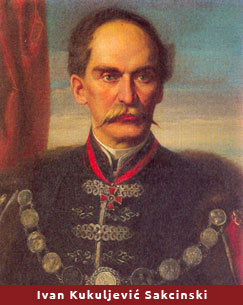 The first idea of
Yugoslavism coincided with the
emergence of the idea of the
development of Yugoslav fine arts.
The Croatian historian Ivan
Kukuljević Sakcinski was the first
to undertake encyclopedic work in
the field of fine arts among the
South Slavs. He wrote Slovnik
umjetnikah jugoslavenskih (A Lexicon
of Yugoslav Artists) presenting the
knowledge about Croatian, Serbian,
and Slovenian artists.. It was
published in five volumes from 1858
to 1860. As he emphasized, the idea
was to compile the first lexicon of
South Slavic artists, since there
were no other people, except the
Slavs, who had no art history and
that “the knowledge and education of
every people are judged on the basis
of their scientific and art
history”.1 It is evident that, in
accordance with the dominant ideas
of his time, Sakcinski advocated the
opinion that national and cultural
affirmations were closely related
and that art history could
contribute to nation-building. He
carried out the work on Slovnik,
including the gathering of material
and preparation of the lexicon for
publication, in cooperation with
other South Slavic intellectuals,
writers and artists. As for the
artists’ lithographs, he said that
they were made by “our prominent
painter and lithographer, Anastas
Jovanović Bugarin”.2 Sakcinski’s
activity was of great significance
because it laid the groundwork for
Yugoslav art history. The first idea of
Yugoslavism coincided with the
emergence of the idea of the
development of Yugoslav fine arts.
The Croatian historian Ivan
Kukuljević Sakcinski was the first
to undertake encyclopedic work in
the field of fine arts among the
South Slavs. He wrote Slovnik
umjetnikah jugoslavenskih (A Lexicon
of Yugoslav Artists) presenting the
knowledge about Croatian, Serbian,
and Slovenian artists.. It was
published in five volumes from 1858
to 1860. As he emphasized, the idea
was to compile the first lexicon of
South Slavic artists, since there
were no other people, except the
Slavs, who had no art history and
that “the knowledge and education of
every people are judged on the basis
of their scientific and art
history”.1 It is evident that, in
accordance with the dominant ideas
of his time, Sakcinski advocated the
opinion that national and cultural
affirmations were closely related
and that art history could
contribute to nation-building. He
carried out the work on Slovnik,
including the gathering of material
and preparation of the lexicon for
publication, in cooperation with
other South Slavic intellectuals,
writers and artists. As for the
artists’ lithographs, he said that
they were made by “our prominent
painter and lithographer, Anastas
Jovanović Bugarin”.2 Sakcinski’s
activity was of great significance
because it laid the groundwork for
Yugoslav art history.
During the second
half of the 19th century a cultural
rapprochement among the South Slavic
peoples continued. At the initiative
of Bishop Josip Juraj Strossmayer,
the Yugoslav Academy of Sciences and
Arts (JAZU) was founded in Zagreb in
1866. It was the first scientific
and cultural institution bearing the
designation “Yugoslav” in its name.
Strossmayer also manifested his
commitment to the Yugoslav idea in
the paintings commissioned for
Djakovo Cathedral. Members of South
Slavic peoples are depicted in the
compositions of the Adoration of the
Magi, Last Judgement and Lamentation
of Christ. The events in Herzegovina
and Montenegro also played a part in
strengthening the Yugoslav idea in
the artistic world. Representations
of the uprisings and struggles
against the Ottoman Empire
popularized the peoples in those
territories among the South Slavs
and beyond. Artists such as Djura
Jakšić, Ferdo Kikerec and Jaroslav
Čermak were inspired by these
events. Strossmayer bought Čermak’s
painting The Wounded Montenegrin and
donated it to the JAZU Gallery.
The idea about
Yugoslav cultural unity reached its
highest point in the late 19th and
early 20th centuries. One of its
manifestations was the joint
Serbian-Slovenian funeral festivity,
involving the transfer of the bodies
of Jernej Kopitar and Vuk Karadžić
from St Marx Cemetery in Vienna to
Ljubljana and Belgrade respectively.
In October 1897, the exhumation and
transfer of their bodies were
organized by the Serbian Royal
Academy and Slovenska Matica
(Slovene Society). This public
manifestation was the testimony to
strong South Slavic
interconnectivity, based on cultural
cooperation.
The year 1904
played a major role in the
development of the Yugoslav cultural
idea since it brought a great
political change in the Kingdom of
Serbia. The royal throne was mounted
by Peter I Karadjordjević, while
state cultural policy began
intensively to promote the Yugoslav
idea. Yugoslavism was already
highlighted during the coronation
celebrations and served as
propaganda for King Peter I
Karadjordjević.
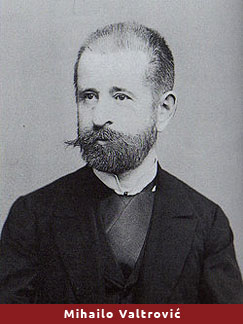 The First Yugoslav
Art Exhibition was organized on the
basis of the idea and advocacy of
Mihailo Valtrović, a renowned
professor at the Great School, about
the joint exhibition activity of
Yugoslav artists. The exhibition was
formally organized by the Great
School students in Belgrade, but its
initiators were Valtrović and his
younger associate, archeologist
Miloje Vasić. The Serbian state
stood behind the organisation of the
whole event. The exhibition was
staged on the premises of the Great
School in September 1904. It was
opened by King Peter I
Karadjordjević and the works were
exhibited by Serbian, Croatian,
Slovenian and Bulgarian artists. The
exhibition was of crucial
importance. It demonstrated the
unity of Yugoslav artists, new
artistic trends were presented to
the public and the paintings of
Croatian, Serbian and Slovenian
artists were bought for the Yugoslav
Gallery in the National Museum in
Belgrade. The First Yugoslav
Art Exhibition was organized on the
basis of the idea and advocacy of
Mihailo Valtrović, a renowned
professor at the Great School, about
the joint exhibition activity of
Yugoslav artists. The exhibition was
formally organized by the Great
School students in Belgrade, but its
initiators were Valtrović and his
younger associate, archeologist
Miloje Vasić. The Serbian state
stood behind the organisation of the
whole event. The exhibition was
staged on the premises of the Great
School in September 1904. It was
opened by King Peter I
Karadjordjević and the works were
exhibited by Serbian, Croatian,
Slovenian and Bulgarian artists. The
exhibition was of crucial
importance. It demonstrated the
unity of Yugoslav artists, new
artistic trends were presented to
the public and the paintings of
Croatian, Serbian and Slovenian
artists were bought for the Yugoslav
Gallery in the National Museum in
Belgrade.
Up to the World
War I, Yugoslav art exhibitions were
also staged in Sofia in 1906, Zagreb
in 1908 and Belgrade in 1912. At the
Second Yugoslav Exhibition in Sofia,
the joint artistic society Lada was
founded. This society became the
organizer of future exhibitions.
Yugoslav exhibitions made a
considerable contribution to the
formation of a common South Slavic
cultural space, while other similar
activities were also initiated. The
artists who were dissatisfied with
Lada, which functioned on the
federal principle and had national
sections, organized the Yugoslav Art
Colony. It operated as an
association of integral Yugoslavs
and included Nadežda Petrović, Ivan
Meštrović, Ferdo Vesel, Emanuel
Vidović, Ivan Grohar and Rihard
Jakopič. The First Dalmatian
Exhibition in Split in 1908 and the
exhibition entitled “Despite
Unheroic Times” held in Zagreb in
1910 also had pro-Yugoslav
programmes.
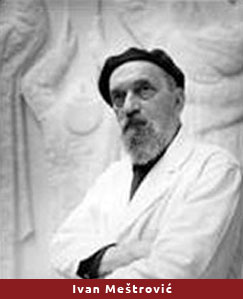 The pro-Yugoslav
cultural policy pursued by Belgrade
after 1904 also resulted in the
commissioning of Ivan Meštrović to
design public monuments in Serbia.
In any case, he had always declared
himself a Yugoslav artist. He held
that the cultural basis of a common
Yugoslav identity should be sought
in epic poetry. He saw in the Kosovo
Cycle both Serbian and Yugoslav
mythology, so he designed the
Vidovdanski Hram (St Vitus’ Day
Temple) as a monument to Yugoslav
folk religion. The pro-Yugoslav
cultural policy pursued by Belgrade
after 1904 also resulted in the
commissioning of Ivan Meštrović to
design public monuments in Serbia.
In any case, he had always declared
himself a Yugoslav artist. He held
that the cultural basis of a common
Yugoslav identity should be sought
in epic poetry. He saw in the Kosovo
Cycle both Serbian and Yugoslav
mythology, so he designed the
Vidovdanski Hram (St Vitus’ Day
Temple) as a monument to Yugoslav
folk religion.
Meštrović was also
entrusted with the design of the Art
Pavilion of the Kingdom of Serbia at
the International Exhibition in Rome
in 1911. At the invitation of the
Serbian government, a group of
Croatian artists led by Meštrović
exhibited their works in the Serbian
pavilion. Meštrović, Ljubo Babić,
Mirko Rački, Vladimir Becić and
other Croatian artists exhibited
works inspired by the Kosovo Cycle,
the central theme of the pavilion.
This was a clear sign of their
Yugoslav commitment and a strong
political message to the
international public. At the same
time, Paja Jovanović, celebrated as
a great Serbian painter, exhibited
his works in the Austrian pavilion.
During World War
I, the significance of culture and
art in the presentation of
pro-Yugoslav ideas did not decline.
On the contrary, art became one of
the important testimonies to the
existence of the Yugoslav nation, as
well as a means for spreading the
idea of a Yugoslav state. Ivan
Meštrović took an active part in the
Yugoslav Committee which, within the
scope of its propaganda activities,
organized numerous exhibitions. The
most important propaganda and
exhibition projects included
Meštrović’s exhibition at the
Victoria and Albert Museum in London
in 1915 and joint exhibitions by
Yugoslav artists in Lyons in 1917
and Geneva in 1918.
IN THE KINGDOM
The end of World
War I and the creation of the
Kingdom of Serbs, Croats and
Slovenes represented a new social
and political reality. The Kingdom
brought together peoples who had
lived in different cultural
environments. The territory occupied
by the new state had a different
historical and cultural past, which
was reflected in all aspects of
public and private life. Urban
design, public monuments, artistic
life, cultural institutions, the
appearance and furnishing of private
spaces, as well as the cultural
identity of the population differed
very much in the region, from
Slovenia to Macedonia.
Under the new
conditions, the creation of a single
state and national cultural and
artistic identity imposed itself as
an important question. Emphasis was
laid on the transition to a new
phase in the creation/unification of
the Yugoslavs. However, the pre-war
enthusiasm of the pro-Yugoslav
artistic and cultural elites began
to fade away in the complex reality
of the new state. The further
development and strengthening of the
Yugoslav idea gave way to the
beginning of inter-ethnic political
struggles. In such circumstances, a
very complex cultural situation,
coupled with different concepts of
understanding Yugoslavism was
created. This also influenced the
adoption of different artistic
practices aimed at highlighting and
building a state and national
identity, as well as monarchist
propaganda. Fine arts, architecture
and public monuments were building
the cultural identity of Yugoslavia,
but the process was neither
harmonized nor conceptually unique.
Artistic life was
marked by the individual commitments
and aspirations of artists in
displaying their artistic
expression, on the one hand, and
efforts to create a Yugoslav
artistic culture, on the other. In
the post-war period, artistic life
was gradually restored. The majority
of artists turned to the most
important European center – Paris,
from which new ideas and modernist
stylistic beliefs were brought to
the country. Thus, there was a
generation of artists in the
Yugoslav space whose work was
harmonized with contemporary
European artistic ideals. The most
distinguished artists among them
included, inter alia, Sava
Šumanović, Marin Tartaglia, Petar
Palavičini, Jovan Bijelić, Lazar
Ličenoski, Ivan Tabaković, Krsto
Hegedušić, Tone Kralj, Lojze
Dolinar, Rihard Jakopič... At the
same time, authentic avant-garde
movements, such as Zenit, also
emerged in the Yugoslav space.
Although the most current trend on
the art scene was not primarily
concerned with the issues of
Yugoslavism in art, various
activities were carried out with the
aim of contributing to the creation
of a common Yugoslav identity.
The organisation
of Yugoslav art exhibitions
continued in the post-war period,
but without the participation of
Bulgarian artists. The Fifth
Yugoslav Art Exhibition, staged in
Belgrade in 1922, was an event that
accompanied the wedding ceremony of
King Alexander I Karadjordjević and
Princess Maria of Romania. Due to
its connection with current
monarchist events, this exhibition
resembled the First Yugoslav Art
Exhibition held in 1904. However,
the 1904 exhibition marked a new
pro-Yugoslav state policy, while the
1922 exhibition pointed up King
Alexander’s authoritarian and
personal regime. It can even be said
that it represented the humiliation
of the Yugoslav art scene and its
reduction to an ancillary wedding
event. The last, Sixth, Yugoslav
Exhibition was held in Novi Sad in
1927. It was part of the celebration
of the 100th anniversary of Matica
Srpska and the accompanying
exhibition was dedicated to old
Serbian painting in Vojvodina. The
organisation of these two Yugoslav
exhibitions was supported by the
authorities, but they did not
achieve great success. It was not
recorded that it attracted greater
public interest, while the Novi Sad
exhibition was largely ignored by
the Yugoslav public. Many
significant artists did not
participate in these exhibitions,
including Ivan Meštrović, the most
important adherent of Yugoslavism
among artists.
Yugoslav artists
continued to jointly exhibit their
works in the Spring Salon held at
the Cvijeta Zuzorić Art Pavilion in
Kalemegdan. Up to 1931, its sponsor
was Prince Paul Karadjordjević, who
had distinguished himself as an art
lover and collector. However, the
crisis of the Yugoslav idea in art
was evident. The exhibitions in the
Spring Salon had a Yugoslav
character, but they were not
accepted by artists from all parts
of the state. Thus, they had great
significance for the artistic life
of Belgrade, but their political,
Yugoslav character was not
successfully realized.
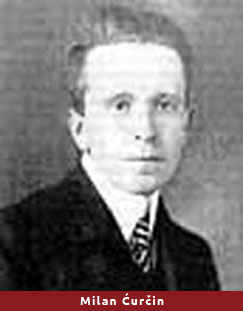 While the
organisation of artistic life at the
federal level was faltering and
weakening, integral Yugoslavs were
distinguishing themselves in
political and cultural life. In
Zagreb, Milan Ćurčin launched the
journal Nova Evropa 1920, rallying
integral Yugoslavs. They promoted
Ivan Meštrović as the leading
Yugoslav artist, while his work was
intensively followed and
popularized. While the
organisation of artistic life at the
federal level was faltering and
weakening, integral Yugoslavs were
distinguishing themselves in
political and cultural life. In
Zagreb, Milan Ćurčin launched the
journal Nova Evropa 1920, rallying
integral Yugoslavs. They promoted
Ivan Meštrović as the leading
Yugoslav artist, while his work was
intensively followed and
popularized.
The efforts of
integral Yugoslavs were not
completely recognized. Meštrović,
who had been engaged in pro-Yugoslav
efforts since 1904 and had taken an
active part in the Yugoslav
Committee during World War I, did
not retain the same position in the
newly- created state. His most
ambitious project – St Vitus’ Day
Temple - was not realized. Moreover,
some of the Serbian authorities
criticized his artistic conception,
especially his naked statues of
heroes.
Meštrović’s work
often combined sculptural and
architectural projects. The public
function of architecture highlighted
its significance in mapping and
characterising specified spaces.
Expressing Yugoslavism in
architecture was not monolithic.
Meštrović was the exponent of the
so-called primordial approach, but
different ideas and practices of
highlighting Yugoslavism in
architecture were still preserved.
Thus, buildings with different
stylistic and construction features
were considered part of Yugoslav
architecture. In the 19th century,
the Serbian-Byzantine architectural
style was created for the needs of
Serbian public buildings. In the
post-war period, it was primarily
characteristic of Orthodox Church
buildings throughout Yugoslavia.
The territory of
the new state was also marked by
public monuments. The monuments to
Habsburg rulers in the regions that
once belonged to Austria-Hungary
were demolished. Monuments to
monarchs from the Karadjordjević
dynasty were erected throughout the
country. Hence, for example, the
Croatian sculptor Rudolf Valdec made
monuments dedicated to King Petar in
Veliki Bečkerek and Bijeljina. After
King Alexander’s assassination, the
erection of monuments dedicated to
him began. Monuments were also
erected in memory of the Serbian
soldiers killed in the Balkan Wars
and World War I. One of the most
significant monuments, designed by
architect Momir Korunović, was
erected at Zebrnjak near Kumanovo.
Inscriptions on these military
monuments emphasized that they were
erected to the soldiers fallen for
liberation and unification, thus
giving them both a Serbian and
proto-Yugoslav character.3
The creation of
the new state had a positive effect
on presenting the cultural wealth of
the Yugoslav peoples. In the period
before World War I, when the
artistic heritage of the South Slavs
was largely denied, especially by
the Austro-Hungarian elite, an
Orientalist view of the Balkans
colored the perception of cultural
heritage and gave rise to the belief
that folklore was the highest South
Slavic cultural achievement. Hence,
in the inter-war period, a process
of cultural heritage research and
presentation was initiated.
Intensive medieval and antique
heritage research was carried out in
the area from Dalmatia to Macedonia.
New cultural institutions, such as
the Museum of Southern Serbia in
Skopje, were also established. Their
work was coordinated with the
dominant political ideology of the
state.
A significant tone
to artistic life was given by
members of the ruling Karadjordjević
family. Apart from the constant use
of artistic events for their
propaganda, the Karadjordjević
rulers also tried to present
themselves as bearers and guardians
of the Yugoslav idea. Apart from
extensive visual propaganda, two
examples likewise show the extreme
monarchist use of art. King
Alexander used the citizens’
initiative for the erection of the
Monument to the Unknown Soldier on
Mount Avala. He demolished the
existing monument and the medieval
fortified town of Žrnov. He
commissioned Ivan Meštrović to
design a new monument and left his
own imprint on it, which was also
confirmed by the text of the charter
issued on St Vitus’ Day in 1934. It
is stated that the monument is his
endowment “to the eternal memory to
my fallen comrades and as a shining
example to future Yugoslav
generations”. Another example
involves Prince Paul Karadjordjević.
In 1929, he founded the Contemporary
Art Museum in Princess Ljubica’s
Residence in Belgrade. During 1935,
at the initiative of Prince Paul,
who was acting as Regent of
Yugoslavia, this institution and the
National Museum of Belgrade merged
into the Prince Paul Museum, which
was located at the New Royal Palace.
In this way Prince Paul
distinguished himself in the public
eye and placed the museologized
artistic heritage of the Serbian
people at the service of his
propaganda.
IN SOCIALIST YUGOSLAVIA
After World War
II, under new social and political
conditions, the role of art in
Yugoslav society was significantly
reassessed. The most important issue
became the ideology of art and its
role in building a socialist
society. The first post-war years
were marked by the development of
art based on the Soviet model and
efforts to define Socialist Realism.
The thematic framework took
precedence over artistic
considerations, so that art
concentrated on memorizing and
celebrating the Partisan struggle in
World War II and the building of a
new socialist society. Early art
production in socialist Yugoslavia
was also modelled on Soviet art. The
best-known Socialist Realist
paintings are those like Boža Ilić’s
“Exploratory drilling in New
Belgrade”. The Soviet influence also
left a significant imprint on
memorial sculpture. This is
evidenced by the imposing monument
to the fallen soldiers of the Red
Army in Batina, designed by Antun
Augustinčić and built from 1945 to
1947 and the monument to the fallen
soldiers at Iriški Venac designed by
sculptor Sreten Stojanović in 1951.
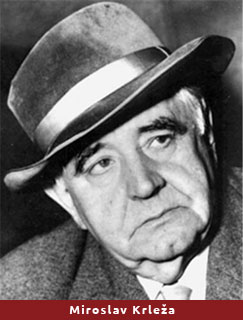 Reactions to
Socialist Realist trends appeared
after the breakaway from the Soviet
Union. A significant event took
place at the Writers’ Congress in
Ljubljana in 1952, where Miroslav
Krleža delivered a speech that
marked a symbolic turning-point in
Yugoslavia’s cultural policy. Among
other things, Krleža criticized
Soviet Socialist Realism in
painting, which he perceived as a
revival of bourgeois academic forms.
He pointed to the many positive
sides of the modern experience, “art
for art’s sake”, and added that
modern painting “addressed ...a
whole universe of details and
nuances of lighting and form,
motives being authentic and
important for the intensity of the
realistic human experience of
reality...”4 Krleža pleaded for
freedom of creativity and concluded
that “our own Art will be born with
the appearance of artists who will
know how to ‘express the objective
motives of our leftist reality
subjectively’ thanks to their
talent, their knowledge and their
taste. If we develop a socialist
cultural medium that will be aware
of its rich past and its cultural
mission in the current European
space and time, our Art will
inevitably appear”5 Departure from
the Soviet model had a great impact
on Yugoslav art. Art was freed from
the shackles imposed by party
policy, while modernist expression
became one of the characteristics of
Yugoslav artistic practice.
Modernism became not only the
dominant art trend, but also an
important foreign policy element.
Yugoslav modern art was presented at
numerous international exhibitions,
thus demonstrating Yugoslavia’s
specificity in the socialist world,
distancing itself from the Soviet
Union and Socialist Realist art, as
well as belonging to more culturally
developed countries. Reactions to
Socialist Realist trends appeared
after the breakaway from the Soviet
Union. A significant event took
place at the Writers’ Congress in
Ljubljana in 1952, where Miroslav
Krleža delivered a speech that
marked a symbolic turning-point in
Yugoslavia’s cultural policy. Among
other things, Krleža criticized
Soviet Socialist Realism in
painting, which he perceived as a
revival of bourgeois academic forms.
He pointed to the many positive
sides of the modern experience, “art
for art’s sake”, and added that
modern painting “addressed ...a
whole universe of details and
nuances of lighting and form,
motives being authentic and
important for the intensity of the
realistic human experience of
reality...”4 Krleža pleaded for
freedom of creativity and concluded
that “our own Art will be born with
the appearance of artists who will
know how to ‘express the objective
motives of our leftist reality
subjectively’ thanks to their
talent, their knowledge and their
taste. If we develop a socialist
cultural medium that will be aware
of its rich past and its cultural
mission in the current European
space and time, our Art will
inevitably appear”5 Departure from
the Soviet model had a great impact
on Yugoslav art. Art was freed from
the shackles imposed by party
policy, while modernist expression
became one of the characteristics of
Yugoslav artistic practice.
Modernism became not only the
dominant art trend, but also an
important foreign policy element.
Yugoslav modern art was presented at
numerous international exhibitions,
thus demonstrating Yugoslavia’s
specificity in the socialist world,
distancing itself from the Soviet
Union and Socialist Realist art, as
well as belonging to more culturally
developed countries.
Modern painting
was also accepted to a certain
extent by Josip Broz Tito. His
personality was promoted in all the
media, including the fine arts.
Artists were commissioned to paint
his portrait. Tito was even painted
by Paja Jovanović, the artist who
had painted portraits of Emperor
Franz Joseph, King Alexander and
Queen Maria Karadjordjević during
his long career. Over time, Božidar
Jakac’s drawing of Tito in profile
and August Augustinčić’s sculpture
in Kumrovec were selected as the
“canonic portraits” of Tito and were
widely reproduced. Josip Broz
adopted a critical stance towards
abstraction and preferred figural
art. According to Miodrag Protić, he
visited the Contemporary Art Museum
in Belgrade only once. On that
occasion, he said that he liked
Miljenko Stančić’s painting.
Although Tito disapproved of
abstraction, his personal taste and
attitude did not stop the trends in
modern Yugoslav art. Censorship was
primarily practised when Tito’s
personality was criticized.6 In 1974,
the opening of Mića Popović’s
exhibition was cancelled due to his
paintings “Richard of Tito’s Face”
and “Ceremonial Painting”.
Miroslav Krleža
was one of the most important
figures in the conception and
creation of the image of Yugoslav
art and culture. Apart from pleading
for the modernisation of artistic
practice, as Director of the
Yugoslav Lexicographical Institute
in Zagreb and editor-in-chief of
numerous encyclopaedic editions, he
had insight and partial control in
writing about the artistic past.
Krleža did not have a high opinion
of 19th-century academic artistic
practice; he saw the basis of the
Yugoslav artistic identity in
medieval times. He was one of the
main organizers and author of the
preface to the catalogue of the
exhibition of Yugoslav medieval art,
held in Paris in 1950 and Zagreb in
1951. Krleža’s basic idea was that
the Yugoslav peoples had advanced
medieval culture and civilisation,
“which vanished in the whirlpool of
the 600-year Turkish, Austrian and
Venetian wars from the 14th to the
20th century”.7 For Krleža, a
reference to medieval times was
closely related to the contemporary
socialist Yugoslav state: “Today,
the contemporary South Slavic
socialist anticipation is only a
dialectical pendant on the whole
range of our medieval anticipations,
Old Slavic, Glagolitic, the
Cyril-Methodian struggle for the
equality of ethnicities and
languages... the Bogumil lay
revolution... and, finally, the
anticipation of pre-Giotto and
neo-Hellenistic painting...
producing several artistic works on
our soil, at Sopoćani and Mileševa,
which can be compared to the
masterpieces of mature Renaissance
art in Western Europe which, in
terms of their artistic value, can
be compared to mature Renaissance
masterpieces in Western Europe”.8
Krleža considered Yugoslav medieval
art, especially the Bogumil
heritage, to be an antithesis to
Byzantium and Rome and the third
component of European art of that
period. Such views could provide a
basis for the cultural and political
position of socialist Yugoslavia and
its third way.
In socialist
Yugoslavia, the issue of Yugoslavism
in art was being slowly pushed into
the background. Artistic practice
and theory were evolving within the
framework of global modernist
trends. Modern art was becoming the
dominant artistic expression, while
current art trends were adopted and
evolved simultaneously with the
world’s artistic centers. Art
informel, abstract art,
constructivism and conceptual art
marked the decades from the
liberalisation of artistic practice
to the collapse of the Socialist
Federal Republic of Yugoslavia. The
openness of Yugoslav society towards
modern art was also demonstrated by
the organisation of significant
exhibitions of world modernity. One
of the most important exhibitions
was the exhibition of Henry Moore’s
sculptures at the Cvijeta Zuzorić
Art Pavilion in Belgrade in 1955,
which marked a turning-point in
Yugoslavia’s artistic life.
Artistic life in
the Socialist Federal Republic of
Yugoslavia was experiencing a rapid
rise. Most republics had fine arts
academies that educated generations
of painters, sculptors and graphic
artists. Republican associations of
fine artists as well as a similar
association at federal level were
also established with the aim of
contributing to the better status of
artists in society. Exhibition
activity was developing throughout
Yugoslav territory. Apart from
salons, staged in the capitals of
the federal republics, some
exhibitions had a federal character.
For example, Tuzla was the venue of
Yugoslav portrait exhibitions, the
Yugoslav Youth Biennial in Rijeka
was staged in Rijeka from 1961 to
1991, the Biennial of Yugoslav
Student Drawing was held in the
Students’ Town Gallery in Belgrade,
the Yugoslav Drawing Triennial was
held in Sombor and the Yugoslav
Ceramics Triennial was held at the
Applied Art Museum in Belgrade,
while Yugoslav Graphic Art
Exhibitions were staged in Zagreb
and Belgrade.
The most important
public monuments erected throughout
the Socialist Federal Republic of
Yugoslavia were memorials dedicated
to the victims and heroes of World
War II. Monumental culture was
undergoing transformation from
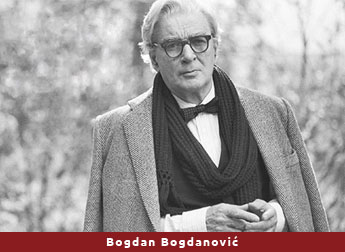 post-war Socialist Realist memorials
to modern monuments. The
modernisation and creation of a
unique artistic expression is
exemplified in the monuments
designed by architect Bogdan
Bogdanović. By developing archaic
visual forms, Bogdanović endowed his
sculptures with complex symbolism
and humanist meaning. His monuments,
erected throughout Yugoslavia – in
Mostar, Belgrade, Kruševac and
Jasenovac, became universal symbols
of the horrors of war, crossing
dogmatic-ideological and
republican-national boundaries. post-war Socialist Realist memorials
to modern monuments. The
modernisation and creation of a
unique artistic expression is
exemplified in the monuments
designed by architect Bogdan
Bogdanović. By developing archaic
visual forms, Bogdanović endowed his
sculptures with complex symbolism
and humanist meaning. His monuments,
erected throughout Yugoslavia – in
Mostar, Belgrade, Kruševac and
Jasenovac, became universal symbols
of the horrors of war, crossing
dogmatic-ideological and
republican-national boundaries.
An important place
in cultural life was held by
institutions promoting Yugoslav art
occupied an important place in
cultural life.. One institution with
a Yugoslav character was the
Contemporary Art Museum. Originally
called the Modern Gallery in 1958,
the museum was formally founded –
according to its founder and
director Miodrag B. Protić – as an
institution of the People’s Republic
of Serbia but, according to its
programme, it had a Yugoslav
character. Protić bought up artworks
from Serbia, Croatia and Slovenia,
thus creating the "most complete and
most valuable collections of
20th-century Serbian and Yugoslav
art”.9 A new modern building was also
erected to serve the needs of the
museum. Designed by architects Ivan
Antić and Ivanka Raspopović, it
opened on 20 October 1965. It was
aimed at promoting Yugoslav modern
art, while at the same time
representing the most significant
project in the artistic life of
Belgrade and Serbia.10 The museum
contained the works of artists from
all parts of the country, while
20th-century Yugoslav art was
presented at accompanying
exhibitions and in programme-related
editions. However, Yugoslav art was
presented not according to its
national characteristics, but
according to its style and
chronology. Modern art was also
promoted by other institutions, such
as the Art Gallery of Bosnia and
Herzegovina, the Modern Gallery in
Ljubljana, the City
Gallery/Contemporary Art Museum in
Zagreb and the Contemporary Art
Museum in Skopje.
Artistic life in
the Federal Republic of Yugoslavia
did not have a unique flow; it also
mirrored the dynamics of ongoing
events in the country. Apart from
positive modern and integration
trends at the federal level,
disintegration processes were also
underway. The republican Academies
of Sciences and Arts were gradually
becoming the proponents of national
culture. At the same time, the
country’s highest cultural
achievements were denigrated
according to local and ideological
needs. The non-reconciliation of
different views was demonstrated on
numerous occasions and one example
was the demolition of Njegoš’s
chapel and the erection of his
mausoleum on Mount Lovćen, designed
by Ivan Meštrović. This idea was
opposed by the professional
community. Art historians, like
Lazar Trifunović from Belgrade and
Franc Stele from Ljubljana, held
that the chapel should not be
demolished. Their view was shared by
Miroslav Krleža, who had voiced a
negative opinion of Ivan Meštrović’s
work in the inter-war period. He
wrote: “Njegoš’s mausoleum by
Meštrović will be a mausoleum, if it
is ever built, which would certainly
be the better option, since it is
terribly stupid! And it costs a
lot!”11 Despite opposition by a
significant number of Yugoslav
intellectuals, the Municipality of
Cetinje carried through this idea
and erected Ivan Meštrović’s
monument. At that time, he himself
was living as an emigré in the
United States.
Differences in the
conceptions and understanding of
culture and art were also reflected
in the preparation of encyclopedic
entries. As can be learned from
Miroslav Krleža’s Marginalije, a
covert war between the republican
editorial boards was underway.
Krleža was highly dissatisfied with
his relationship with the Serbian
editorial board during the
preparation of a Yugoslav art
encyclopedia. He stated bitterly on
a number of occasions that his
initial advocacy of the promotion of
Yugoslav medieval art was being
taken over and used in a Serbian
national context. In one note made
during his work on the encyclopedia
it is stated: “… I have continuous
clashes with ‘experts’ like Djurdje
Bošković, (Radivoje) Ljubinković,
(Dejan) Medaković and the like, who
are forever distorting the meaning
of the theses of this encyclopedia
in their well-known manner where
Serbian-Macedonian issues are
concerned”.12
The examples of
Njegoš’s chapel and work on the
encyclopedia point to the gradual
fragmentation of art and culture in
the Socialist Federal Republic of
Yugoslavia. It is evident that it
was possible to map different
interests in the field of culture.
The bloody collapse of the Socialist
Federal Republic of Yugoslavia
brought about changes in political
circumstances and the cultural
scene, as well as the emergence of
nationalist elites. Some prominent
figures, such as Bogdan Bogdanović,
emigrated, while a great number of
artists found themselves in a
“vacuum”. Educated and doing
creative work in the Yugoslav
context, they could not identify
themselves and their works with the
newly-established nation states.
Another example is Marina Abramović,
the world’s best-known performance
artist from Yugoslavia, who
periodically emphasizes that she
comes from a country that no longer
exists.13
The idea of
Yugoslav art was closely related to
the rise, duration and fall of the
Yugoslav idea. From the mid-19th
century, South Slav artists began to
establish mutual relations and
organize themselves with a view to
presenting the cultural and ethnic
closeness of the South Slav peoples.
The formation of a common state, the
Kingdom of Serbs, Croats and
Slovenes/Yugoslavia, did not
contribute to the creation of a
common art and culture. The cultural
differences among the Yugoslav
peoples and different political
interests weakened the idea of a
common artistic identity. A specific
phenomenon was the rise of the
integral Yugoslav Ivan Meštrović, an
artist who embodied the Yugoslav
spirit. After World War II, the art
of socialist Yugoslavia was geared
towards mastering modern artistic
expression. The negative trends that
were leading towards the collapse of
the state were strengthening
republican and national movements.
The initial idea of creating the art
of the Yugoslav nation was not
realized. However, the existence of
a common state did bring about the
creation of a cultural and artistic
space and the formulation of
Yugoslav art as the artistic
practice developed in the Yugoslav
territory.
|